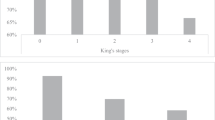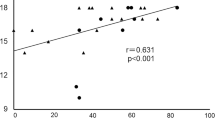Abstract
Using data from the PRIAMO study, we investigated non-motor symptoms (NMS) versus frontal lobe dysfunction in patients with idiopathic Parkinson disease (PD); 808 patients with PD and 118 with atypical parkinsonisms (AP) were consecutively enrolled at 55 Centers in Italy. Twelve categories of NMS were investigated. Cognitive impairment was defined as a Mini-Mental Status Evaluation score ≤23.8 and frontal lobe dysfunction as a Frontal Assessment Battery (FAB) score ≤13.48. Multivariable logistic regression was used to identify predictor of frontal lobe dysfunction in 524 PD patients, and a generalized linear model was used for each of the six FAB items. Not only the total FAB scores but also the single FAB items were lower in AP versus PD (p ≤ 0.005). Age (OR = 1.05), cognitive impairment (OR = 9.54), lack of cardiovascular symptoms (OR = 3.25), attention or memory problems (OR = 0.59) and treatment with l-DOPA (OR = 5.58) were predictors of frontal lobe dysfunction. MMSE was negatively associated with all FAB items (β ≤ −0.16) and age with all FAB items but prehension behavior (β ≤ −0.01). Previous use of l-DOPA was negatively associated with verbal fluency (β = −0.32) possibly acting as surrogate marker of disease duration. Cognitive impairment is a predictor of frontal lobe dysfunction. Among NMS, lack of attention or memory problems were negatively associated with frontal impairment. Further studies are nonetheless needed to better identify the predictors of frontal impairment in PD patients.


Similar content being viewed by others

References
Pillon B, Dubois B, Agid Y (1996) Testing cognition may contribute to the diagnosis of movement disorders. Neurology 46:329–334
Gotham AM, Brown RG, Marsden CD (1988) ‘Frontal’ cognitive function in patients with Parkinson’s disease ‘on’ and ‘off’ levodopa. Brain 11:299–321
Robbins TW, James M, Owen AM et al (1994) Cognitive deficits in progressive supranuclear palsy, Parkinson’s disease, and multiple system atrophy in tests sensitive to frontal lobe dysfunction. J Neurol Neurosurg Psychiatry 57:79–88
Soliveri P, Monza D, Paridi D et al (2000) Neuropsychological follow up in patients with Parkinson’s disease, striatonigral degeneration-type multisystem atrophy, and progressive supranuclear palsy. J Neurol Neurosurg Psychiatry 69:313–318
Dubois B, Slachevsky A, Litvan I, The PillonB, AB F (2000) A frontal assessment battery at bedside. Neurology 56:1621–1626
Slachevsky A, Villalpando JM, Sarazin M et al (2004) Frontal assessment battery and differential diagnosis of frontotemporal dementia and Alzheimer disease. Arch Neurol 61:1104–1107
Iavarone A, Ronga B, Pellegrino L et al (2004) The Frontal Assessment Battery (FAB): normative data from an Italian sample and performances of patients with Alzheimer disease and frontotemporal dementia. Funct Neurol 19:191–195
Paviour DC, Winterburn D, Simmonds S et al (2005) Can the frontal assessment battery (FAB) differentiate bradykinetic rigid syndromes? Relation of the FAB to formal neuropsychological testing. Neurocase 11:274–282
Folstein MF, Folstein SE, McHugh PR (1975) Mini-mental state. A practical method for grading the cognitive state of patients for the clinician. J Psychiatr Res 12:189–198
Antonini A, Colosimo C, Marconi R, Morgante L, Barone P (2008) The PRIAMO study: background, methods and recruitment. Neurol Sci 29:61–65
Barone P, Antonini A, Colosimo C et al (2009) The Priamo study: a multicenter assessment of nonmotor symptoms and their impact on quality of life in Parkinson’s disease. Mov Disord 24:1641–1649
Hoehn MM, Yahr MD (1967) Parkinsonism: onset, progression and mortality. Neurology 17:427–442
Fahn S, Elton R, Members of the UPDRS Development Committee (1987) The unified Parkinson’s disease rating scale. In: Fahn S, Marsden CD, Calne DB, Goldstein M (eds) Recent developments in Parkinson’s disease, vol 2. Macmillan Health Care Information, Florham Park, pp 153–163, 293–304
Hamilton M (1960) A rating scale for depression. J Neurol Neurosurg Psychiatry 23:56–62
Measso GF, Cavarzeran F, Zappalà G et al (1993) The Mini-Mental State Examination: normative study of a random sample of Italian population. Dev Neuropsychol 9:77–85
McDowell I, Newell C (1996) Measuring health: a guide to rating scales and questionnaires. Oxford University Press, New York
Appollonio I, Leone M, Isella V et al (2005) The Frontal Assessment Battery (FAB): normative values in an Italian population sample. Neurol Sci 26:108–116
Bensimon G, Ludolph A, Agid Y et al (2009) Riluzole treatment, survival and diagnostic criteria in Parkinson plus disorders: the NIPPS Study. Brain 132:156–171
Growdon JH, Kieburtz K, McDermott MP, Panisst M, Friedman JH (1998) Levodopa improves motor function without impairing cognition in mild non-demented Parkinson’s disease patients. Neurology 50:1327–1331
Kulisevsky J, Avila A, Barbanoj M, Berthier ML, Gironell A (1996) Acute effects of levodopa on neuropsychological performance in stable and fluctuating Parkinson’s disease patients at different levodopa plasma levels. Brain 119:2121–2132
Poewe W, Berger W, Benke TH, Schelosky L (1991) High-speed memory scanning in Parkinson’s disease: adverse effects of levodopa. Ann Neurol 29:670–673
Pascual-Sedano B, Kulisevsky J, Barbanoj M et al (2008) Levodopa and executive performance in Parkinson’s disease: a randomized study. J Int Neuropsychol Soc 14:832–841
Guedj E, Allali G, Goetz C et al (2008) Frontal Assessment Battery is a marker of dorsolateral and medial frontal functions: a SPECT study in frontotemporal dementia. J Neurol Sci 273:84–87
Konishi S, Nakajima K, Uchida I, Kikyo H, Kameyama M, Miyashita Y (1999) Common inhibitory mechanism in human inferior prefrontal cortex revealed by event-related functional MRI. Brain 122:981–991
Quattrone A, Nicoletti G, Messina D et al (2008) MR imaging index for differentiation of progressive supranuclear palsy from Parkinson disease and the Parkinson variant of multiple system atrophy. Radiology 246:214–221
Santangelo G, Trojano L, Vitale C et al (2007) A neuropsychological longitudinal study in Parkinson’s patients with and without hallucinations. Mov Disord 22:2418–2425
Slachevsky A, Pillon B, Fourneret P et al (2001) Preserved adjustment but impaired awareness in a sensorimotor conflict following prefrontal lesions. J Cogn Neurosci 13:332–340
Gauggel S, Rieger M, Feghoff TA (2004) Inhibition of ongoing responses in patients with Parkinson’s disease. J Neurol Neurosurg Psychiatry 75:539–544
Partiot A, Vérin M, Pillon B et al (1996) Delayed response task in basal ganglia lesions in man. Further evidence for a striate-frontal cooperation in behavioural adaptation. Neuropsychologia 34:709–721
Rogers RD, Sahakian BJ, Hodges JR et al (1998) Dissociating executive mechanisms of task control following frontal lobe damage and Parkinson’s disease. Brain 121:815–842
Muslimovic D, Post B, Speelman JD, Schmand B (2005) Cognitive profile of patients with newly diagnosed Parkinson disease. Neurology 65:1239–1245
Acknowledgments
PRIAMO was supported by an educational grant from Boehringer-Ingelheim Italy. We are grateful to MediData (Modena, Italy) for data collection and statistical analysis and to Sara Rizzoli and Lucia Simoni for help in writing the manuscript.
Author information
Authors and Affiliations
Corresponding author
Additional information
On behalf of the PRIAMO study group.
Appendix: The PRIAMO study group
Appendix: The PRIAMO study group
Steering Committee:
-
Angelo Antonini—IRCCS San Camillo Venice and Parkinson Institute, Istituti Clinici di Perfezionamento, Milano
-
Paolo Barone—Neurodegenerative Diseases Centre, University of Salerno and IDC Hermitage-Capodimonte, Napoli
-
Carlo Colosimo—Sapienza Università di Roma
-
Roberto Marconi—Ospedale della Misericordia, Grosseto
-
Letterio Morgante—Università di Messina, Italy
Participating centers:
-
Benincasa D—Ospedale Sant’Andrea, Sapienza Università di Roma
-
Sensi M—Ospedale Sant’Anna, Ferrara
-
Braga M—Ospedale Civile, Vimercate
-
Capecci M—Ospedale Umberto I, Ancona
-
Caravona N—Sapienza Università di Roma
-
D’Asta G—PO Guzzardi, Vittoria
-
De Falco FA—Ospedale S Maria Loreto Nuovo, Napoli
-
Pezzoli G—Istituti Clinici di Perfezionamento, Milano
-
Di Giovanni M—Ospedale Regionale, Aosta
-
Floris G—Clinica Neurologica, Policlinico Universitario, Monserrato,Cagliari
-
Gallerini S—Ospedale della Misericordia, Grosseto
-
Gurgone G—Azienda Ospedaliera S. Giovanni di Dio, Agrigento
-
Frosini D—Ospedale Santa Chiara, Pisa
-
Meoni S—Clinica Neurologica I, Università di Firenze
-
Savica R—Dipartimento di Neuroscienze, Scienze Psichiatriche ed Anestesiologiche, Università di Messina
-
Moschella V—Policlinico Tor Vergata, Roma
-
Pepe F—Fondazione Poliambulanza, Brescia
-
Petretta V—AORN San Giuseppe Moscati, Avellino
-
Randisi MG—Azienda Ospedaliera S Elia, Caltanissetta
-
Romeno M—Ospedale Villa Sofia CTO, Palermo
-
Picillo M—Università Federico II, Napoli
-
Sorbello V—Policlinico Universitario, Catania
-
Tiple D—Sapienza Università di Roma
-
Guidubaldi A—Università Cattolica S Cuore, Roma
-
Muoio R—IRCCS San Raffaele, Roma
-
Toni V—PO F Ferrari, Casarano
-
Logi C—Ospedale Versilia, Camaiore
-
Bartalini S, Ulivelli M—Policlinico Le Scotte, Siena
-
Perini M, Lanfranchi S—Ospedale S Antonio Abate, Gallarate
-
Griffini S, Troianiello B—Istituto Clinico Città di Brescia
-
Baratti M, Amidei S—Ospedale Ramazzini, Carpi
-
Consoli D, Iellamo M—Ospedale G Iazzolino, Vibo Valentia
-
Cuomo T—Ospedale Civile Umberto I, Nocera Inferiore
-
Scaglioni A, Medici D—Ospedale di Vaio, Fidenza
-
Abbruzzese G, Di Brigida G—Centro Parkinson, Dipartimento di Neuroscienze, Oftalmologia e Genetica, Università degli Studi di Genova, Genova
-
Cocco GA, Agnetti V—Università degli Studi di Sassari, Sassari
-
Cossu G, Deriu M—Azienda Ospedaliera G Brotzu, Cagliari
-
Abrignani M, Modica C—Ospedale San Biagio di Marsala, Marsala
-
Albani G, Pradotto L—Divisione di Neurologia e Neuroriabilitazione, Istituto Auxologico Italiano, IRCCS Piancavallo (Verbania)
-
Martinelli P, Scaglione C—Università di Bologna, Bologna
-
Mucchiut M, Zanini S—Policlinico Universitario, Udine
-
Pennisi F—Ospedale di Castelvetrano, Castelvetrano, Trapani
-
Soliveri P, Albanese A—Istituto Nazionale Neurologico C Besta, Milano
-
Bartolomei L, L’Erario R—Ospedale Civile San Bortolo, Vicenza
-
Capus L, Ferigo L—Ospedale di Gattinara, Trieste
-
Marano R, Nastasi V—Azienda Ospedaliera Papardo, Messina
-
Luciano R, Maiello L—Ospedale Monaldi, Napoli
-
Simone P, Fogli D—Ospedale Casa Sollievo della Sofferenza, San Giovanni Rotondo
-
Lopiano L, Pesare M—ASO Molinette, Torino
-
Nordera G, Pilleri E—Casa di Cura Villa Margherita, Arcugnano
-
Scaravilli T—Azienda Ospedaliera Padova, Padova
-
Giaccaglini E, Alesi C—Ospedale Civile, Jesi, Italy
Sponsorship:
-
Tania Corbetta, Arina Dumitriu, Boehringer Ingelheim, Milano, Italy
Project Management, Statistical Analyses and Data Management:
-
Simona Sgarbi, project leader, MediData Studi e Ricerche, Modena
-
Andrea Rapisarda, clinical project manager, MediData Studi e Ricerche, Modena
-
Sara Rizzoli, Lucia Simoni, statisticians, MediData Studi e Ricerche, Modena
-
Luca Zanoli, clinical data manager, MediData Studi e Ricerche, Modena
-
Alessandra Manfredi, clinical operation specialist, MediData Studi e Ricerche, Modena, Italy
Rights and permissions
About this article
Cite this article
Marconi, R., Antonini, A., Barone, P. et al. Frontal assessment battery scores and non-motor symptoms in parkinsonian disorders. Neurol Sci 33, 585–593 (2012). https://doi.org/10.1007/s10072-011-0807-x
Received:
Accepted:
Published:
Issue Date:
DOI: https://doi.org/10.1007/s10072-011-0807-x



